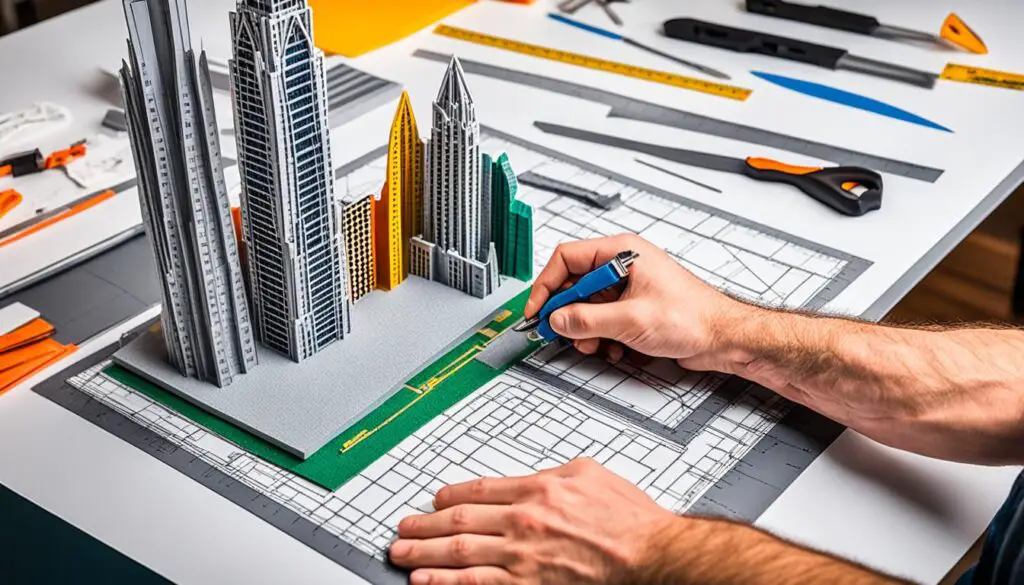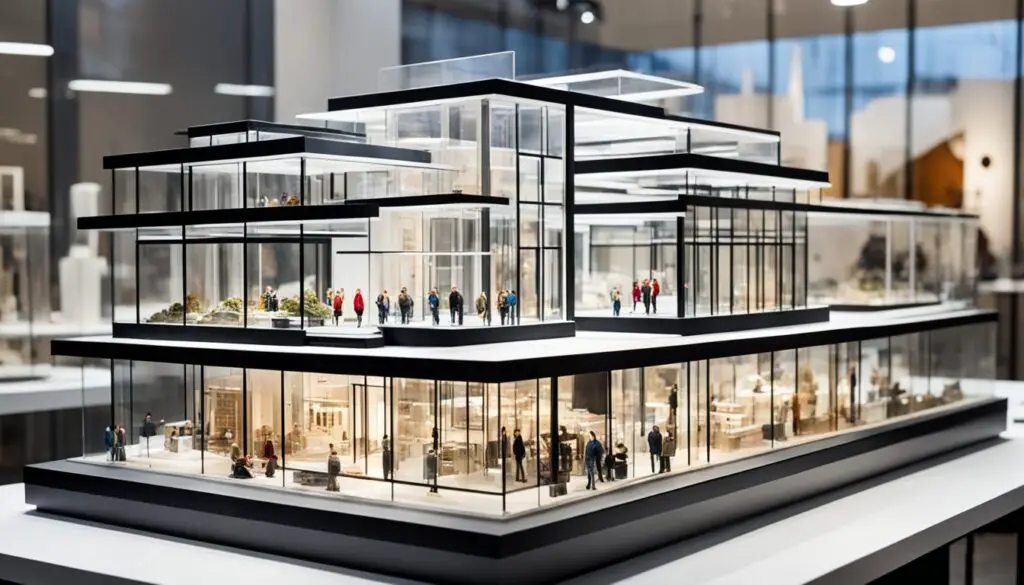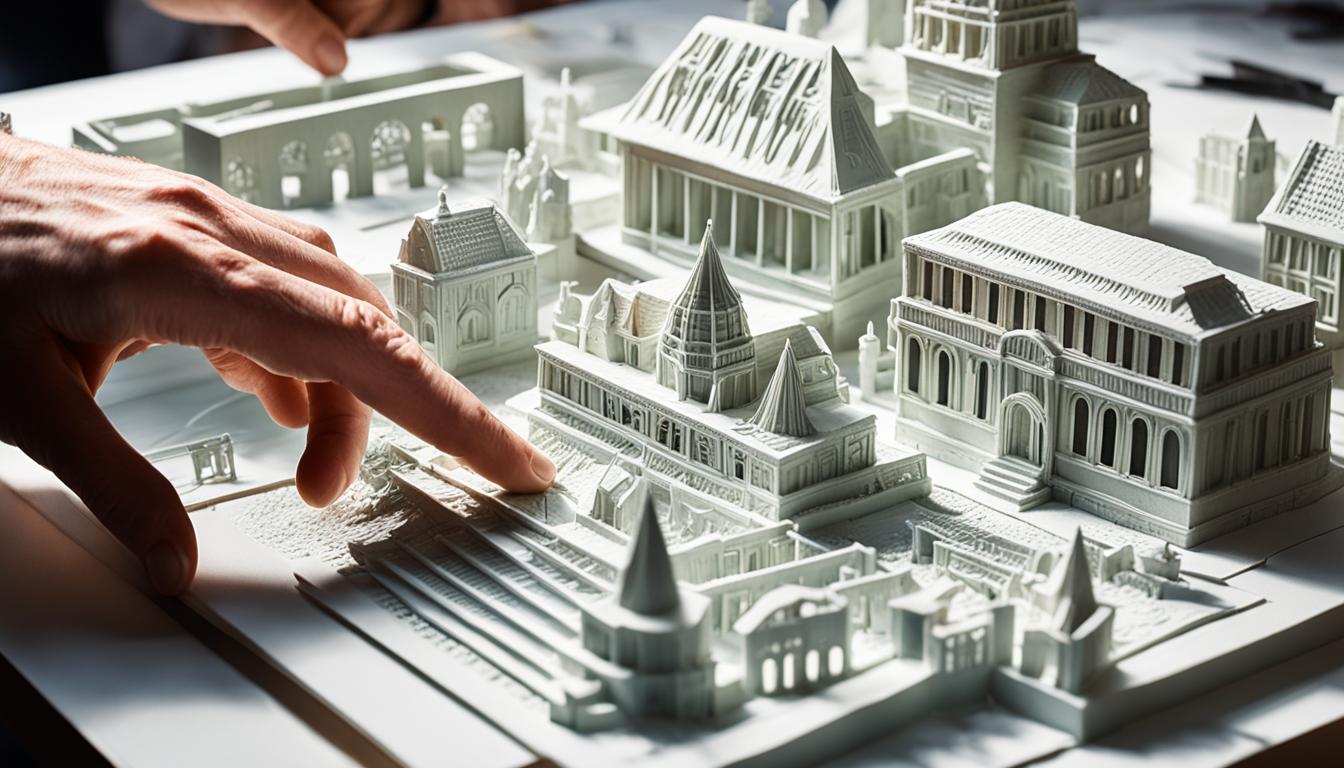The Art of Architectural Model Making: A Step-by-Step Guide
Architectural model making is a precise and intricate craft that allows architects, students, and hobbyists to bring their designs to life in miniature form. Whether you are a professional architect or a passionate hobbyist, creating architectural models is a valuable tool to showcase your design skills and captivate others with your creativity. In this step-by-step guide, I will walk you through the process of architectural model making, providing you with the knowledge and techniques needed to create stunning models.
From choosing the right materials to adding intricate details, this guide covers every aspect of architectural model making. By following these steps, you can elevate your design process and create models that effectively communicate your vision to clients, colleagues, or anyone who sees them.
Key Takeaways:
- Architectural model making allows you to bring your designs to life in miniature form.
- Choosing the right materials is crucial for creating high-quality and realistic models.
- Building techniques, such as cutting, shaping, and gluing, play a vital role in the success of your model.
- Displaying and showcasing your architectural model can effectively communicate your design vision.
- Architectural model making is not only a tool but also an art form that allows you to showcase your creativity and attention to detail.
Choosing the Right Materials for Your Architectural Model
When it comes to architectural model making, selecting the appropriate materials is crucial for achieving a high-quality and realistic result. By carefully considering the materials you use, you can bring your architectural vision to life with precision and craftsmanship. Let’s explore some common materials used in architectural models and their unique characteristics.
Common Materials for Architectural Models
Here are a few materials that are frequently utilized in architectural model making:
- Foam Board: Lightweight and easy to work with, foam board is a popular choice for creating the base structure of architectural models.
- Balsa Wood: Known for its strength and versatility, balsa wood is commonly used for building intricate details and adding texture to architectural models.
- Cardboard: Affordable and readily available, cardboard is suitable for creating larger-scale architectural models and can be easily manipulated into various shapes.
- Acrylic: With its transparent and glossy finish, acrylic is ideal for representing glass surfaces, windows, and other transparent elements in architectural models.
Each material has its own advantages and disadvantages, so it’s important to consider your specific project requirements when making a choice.
Factors to Consider
When selecting materials for your architectural model, you should take into account the following factors:
- Level of Detail: Consider how intricate and precise you want your model to be. Some materials may allow for finer details, while others may be better suited for larger-scale representations.
- Durability: If you intend to handle or transport your architectural model, choose materials that offer durability and resilience.
- Ease of Use: Evaluate the ease of working with each material. Some may require special tools, while others can be easily manipulated with basic equipment.
“Choosing the right materials for your architectural model is essential to achieve a realistic and visually appealing result. Consider factors such as the desired level of detail, durability, and ease of use when making your selection.”
By carefully considering your materials and their characteristics, you can create architectural models that accurately represent your design concepts and effectively communicate your vision.
Building Techniques for Architectural Models
When it comes to creating architectural models, building techniques are the key to achieving professional-quality results. From the initial assembly to the finer details, using the right techniques will elevate your model and bring your design to life. Here are some essential techniques to master:
- Cutting and Shaping Materials: Precise cutting and shaping of materials is crucial for achieving the desired form and proportions. Whether you’re working with foam board, wood, or other materials, using sharp tools and following precise measurements will ensure clean edges and smooth surfaces.
- Gluing and Joining: Properly bonding and joining the different components of your model is essential for its stability and durability. Whether you’re using glue, tape, or other adhesives, make sure to apply them evenly and securely to create strong connections between the parts.
- Painting and Finishing: Adding the right colors and finishes to your model can greatly enhance its realism and visual appeal. Pay attention to details like texture, shading, and weathering to create a lifelike representation of your design.
- Adding Realistic Textures and Details: Small details can make a big difference in the overall realism of your architectural model. Consider using materials like sandpaper, plastic sheets, or textured paints to recreate the textures of different surfaces such as brick, concrete, or glass.
By mastering these architectural model building techniques, you’ll be able to create models that accurately represent your design vision. These techniques allow you to showcase your attention to detail and craftsmanship, resulting in stunning architectural models that captivate viewers.
Take a look at the image below to see an example of how these techniques can be used to create a realistic architectural model:

Showcasing Your Architectural Model
Once you have completed your architectural model, it’s time to showcase it and share your design with others. There are various ways to display and present your architectural model, from simple tabletop displays to professional exhibits. Consider factors such as the size and scale of your model, the intended audience, and the setting in which it will be displayed. A well-presented architectural model can communicate your design vision effectively and leave a lasting impression on viewers.
Whether you’re a professional architect showcasing your latest masterpiece or a student presenting your design project, the way you present your architectural model can greatly enhance its impact. Here are some strategies to help you make the most of your model display:
- Choose the right setting: Consider the environment in which your architectural model will be displayed. Will it be showcased in a gallery, architecture firm, or educational institution? Adjust the display accordingly to create a harmonious and visually appealing presentation.
- Use lighting to your advantage: Proper lighting can highlight the intricate details and features of your architectural model. Experiment with different lighting techniques to create emphasis and enhance the overall visual impact.
- Consider interactive elements: Engage viewers by incorporating interactive elements into your model display. This could include touch screens, videos, or augmented reality features that provide additional information and a more immersive experience.
- Provide context: To help viewers understand your design concept, consider including contextual elements alongside your architectural model. This could be sketches, mood boards, or photographs that capture the inspiration behind your design.
- Label and describe: Clearly label your architectural model with information such as the project name, architect’s name, and key design features. Additionally, provide a brief description or story that gives viewers a deeper understanding of the concept and purpose of your design.
By carefully considering the presentation of your architectural model, you can effectively showcase your design skills and captivate viewers with your creativity and attention to detail. Remember, a well-executed display can make a significant difference in how your architectural model is perceived and appreciated.

Checklist for an Impressive Architectural Model Display
| Setting | Lighting | Interactive Elements | Contextual Elements | Labeling and Description |
|---|---|---|---|---|
| Consider the environment where the model will be displayed. Adjust the display accordingly. | Experiment with different lighting techniques to enhance visual impact. | Incorporate touch screens, videos, or augmented reality features for an immersive experience. | Include sketches, mood boards, or photographs that provide context and inspiration. | Label the model with project name, architect’s name, and key design features. Provide a description or story. |
The Art of Architectural Model Making: A Path to Design Excellence
Architectural model making is not only a valuable tool for architects and designers, but it is also a captivating art form. Through a meticulous step-by-step guide, incorporating the right materials and techniques, you can create impressive architectural models that bring your designs to life. Whether you are a professional architect or a passionate hobbyist, the art of architectural model making offers a unique opportunity to showcase your design skills and captivate viewers with your creativity and attention to detail.
By embracing architectural model making, you can elevate your design process to new heights. The intricate process of constructing architectural models allows for a deeper exploration and understanding of your design concept. It enables you to experiment with different ideas, refine your plans, and communicate your vision effectively. Architectural model making not only enhances your own design capabilities but also allows you to engage and inspire others through the tactile experience of interacting with a physical representation of your design.
Furthermore, architectural model making is a testament to design excellence. It showcases your ability to translate abstract ideas into tangible realities. The precision, craftsmanship, and attention to detail required in creating architectural models mirror the qualities necessary for successful architectural design. Each element, from careful material selection to meticulous building techniques, contributes to the overall aesthetic and impact of the model. In the pursuit of design excellence, architectural model making serves as a powerful tool for pushing boundaries, sparking innovation, and achieving remarkable results.








